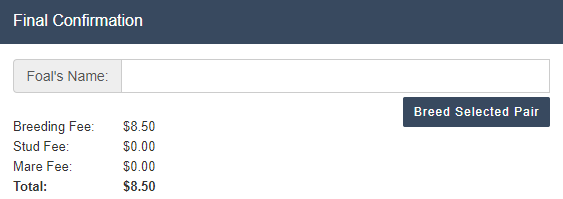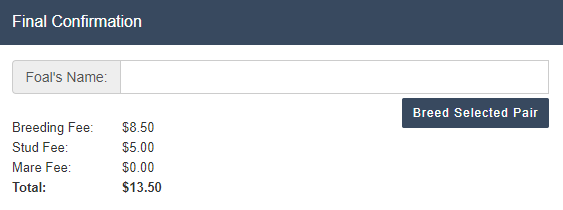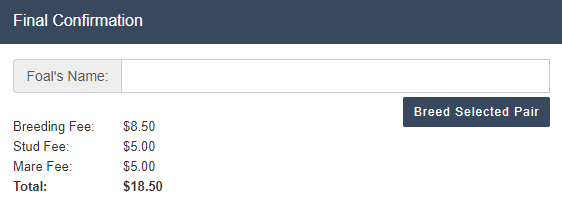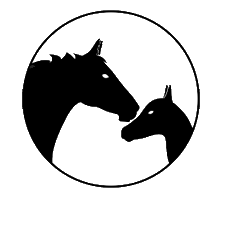Breeding Introduction
Sport of Kings offers a unique way to add horses to your stable.
In addition to claimers, the sales ring and the auction, you can also breed
your own horse. This homebred horse once bred becomes a yearling. This yearling turns
2 and is eligible to race on the first day of the new season.
You can breed from your own sire and mare or use another stables horse.
In fact you don't need to have any breeding horses of your own, it is possible to use sires
and mares from other stables.
However, other stables are NOT obliged to make their
horse avalaible to breed from. Some will though, as this is a source of income for a stable.
Breeding Costs
As mentioned above, you can use you own or horses from another stable.
If you use your own 2 horses, the cost is $8.50.

If you use one of another stables horse then you must pay that stable a fee.
The stud fee in the example below is $5 as this is the price the stable put
on a breed from that particular horse.
So it could be more or less than the example shown.

If you use 2 horses from other stables then you must pay both stud (Sire) and
mare fees.

Acquiring Breeding Horses
To acquire breeding horses, you can- Retire you own horses.
- Buy retired horses at auction.
- Buy retired horses from the stable manager.
- Buy retired horses from other stables.
Breeding Evaluations
Breeding and breeding evaluations are inextricably linked.
If you need to read more about "evaluations" go to the
Evaluations page.
The best stables have built up a database of evaluations and will
always know how a sire and a mare evaluates before breeding from this pair.
Breeding Pre-requisites
There are 2 pre-requisites for a horse to be able to breed.- The horse is 4 years old or older.
- The horse is retired (Therefore a horse that is a breeder cannot race)
Global Breeding Data
If you go to >News >Statistics >Breeding Results SummaryYou will see something like the following table.

This is how I read the data .......
From pairs of horses that evaluated "A-"(of which there was just 24), on average you will breed a 2 star yearling.
In total, there are 11,668 evaluations, just 0.2% give an "A-"" evaluation, so A- pairings are rare
Reading between the lines, does this imply that, to date, no one has or it is actually impossible to get a "A+" evaluation.
Pairs of horses that evaluated "B+"(of which there was 853), on average you will breed a 2 star yearling.
The most common evalaution is "B" (41%)
Most stables are breeding from "B-" or better.
Notes
- Homebred horses on average start life with a lower maturity compared to sales ring horses.
- Breeding top class horses is difficult.
- Mares can breed 2 times per season.
- Sires can breed 20 times per season.
- Take time to learn the nuances of breeding before diving in.
- You will likely breed more poor horses than good ones.
- Good evaluations are no guarantee of success.
Excerpts from Sport Of Kings website
"The best practice is to breed the best to the best and it will increase your chances of getting a quality foal. However, it is important to re-iterate that, just like real life, there are no guaranteed outcomes regardless of how great the pairing of horses.""Generally speaking on the track performance is a good indicator of the overall quality of the horse and it's genetics. A horse can excel on the race track without having good genetics behind it but that is the exception rather than the rule."
"In order to increase the likely hood of a quality foal you should begin by pairing two horses that have demonstrated ability on the track. As previously stated the chances of producing a top offspring increase as the quality of the parents increases and the opposite is equally as true."
"It is advisable to pair horses of similar preferences together in order to match the genetic traits. A turf bloodline should be bred with a turf bloodline and dirt with dirt. Crossing the two can work and you could end up with a horse that will run on both surfaces but the chances of that being successful are not very high."
"Genetics: Each horse has their own qualities that are generally reflected by their genetic composition. Those genetics are what is passed on to the next generation. However, when a pairing occurs there is an event that occurs which determines what genes are carried on to the offspring and which are discarded. You also have dominant genes, non dominant, recessive traits, all of these things that come into play."
"Pairings: To keep it simple you have a set of genetics from the male and the female and which compete against each other to be the one that is carried on. In that competition each has a 'strength' (genetic strength) associated with it. A weak genetic strength means that the genes will be less likely to be carried forward to offspring making the genetics of the partners more likely to come into play."
"Distances: Each horse has a unique distance preference on a scale of 1-10 that is carried in their genetics. When the pairing occurs one of them is selected and used (with some variation possible up and down from that number). So, in this example the mares distance preference was used (which is a long sprint pedigree) and applied to the offspring, resulting in a sprint. It is possible to get a blended result as well (so you could get a middle distance horse from crossing a sprint / stayer) but you would never get a stayer from two sprints or a sprint from two stayers. Adding stamina in the form of a stayer to a sprint mare doesn't ensure that stamina will be passed on, but it is possible."
"Surfaces: It is generally adviseable to pair horses who both enjoy the same type of track and these pairings offer a higher likelyhood of a positive outcome."
Copyright 2020: RacingVirtualhorses.com/.net/.online
